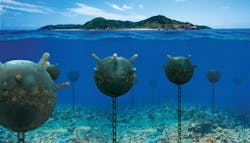Raytheon to build airborne counter-mine and data processing capability to help LCS conduct undersea warfare
WASHINGTON – Undersea warfare experts at Raytheon Technologies Corp. are continuing production of an advanced airborne counter-mine system designed to locate and neutralize bottom and moored ocean mines to help U.S. and allied naval forces operate in littoral zones, confined straits, choke points, and invasion beaches.
Officials of the Naval Sea Systems Command in Washington announced a $16.8 million order last week to the Raytheon Missiles & Defense segment in Portsmouth, R.I., to build Airborne Mine Neutralization Systems (AMNS). With options, this order eventually could be worth $68.6 million.
The Airborne Mine Neutralization System will provide littoral combat ship (LCS) commanders with a rapid, organic counter-mine capability against bottom and moored sea mines. Navy forces will deploy the AMNS from the MH-60 helicopter as part of the LCS mine countermeasures mission module, Navy officials say.
The AMNS deploys explosive mine-destroying ocean vehicles from a launch and handling system (LHS) on the Navy MH-60S helicopter. The mine-destroying unmanned underwater vehicle (UUV) takes its control from the helicopter's common console; it identifies mines before controllers on the helicopter command it to explode and destroy the mine nearby.
The AN/ASQ-235 AMNS consists of two major subsystems: the LHS and the neutralizer. The LHS performs data processing during an AMNS mission, while the LHS manages the neutralizers, and enables the helicopter's common console to communicate with the neutralizers.
The LHS connects with the carriage stream tow and recovery system (CSTRS) and can carry as many as four neutralizers on each mission. Each of the four neutralizers can launch one at a time without recovering the LHS.
The neutralizer communicates with the common console via a fiber-optic data link and provides sonar and video data to operators using the common console. The neutralizer contains a sonar, video camera, and light to find, identify, and attack enemy sea mines.
The neutralizer has six degrees of motion, can maintain a hover position, and can be operated either in automatic or manual mode. The neutralizer also can monitor depth and relative distance from the bottom and can avoid bottom plowing. The operators determine the neutralizer's position with an Integrated Track Point II acoustic tracking system in the LHS.
On this contract modification Raytheon will do the work in Portsmouth, R.I., and should be finished by March 204. For more information contact Raytheon Missiles & Defense online at www.raytheonmissilesanddefense.com, or Naval Sea Systems Command at www.navsea.navy.mil.
About the Author
John Keller
Editor-in-Chief
John Keller is the Editor-in-Chief, Military & Aerospace Electronics Magazine--provides extensive coverage and analysis of enabling electronics and optoelectronic technologies in military, space and commercial aviation applications. John has been a member of the Military & Aerospace Electronics staff since 1989 and chief editor since 1995.
